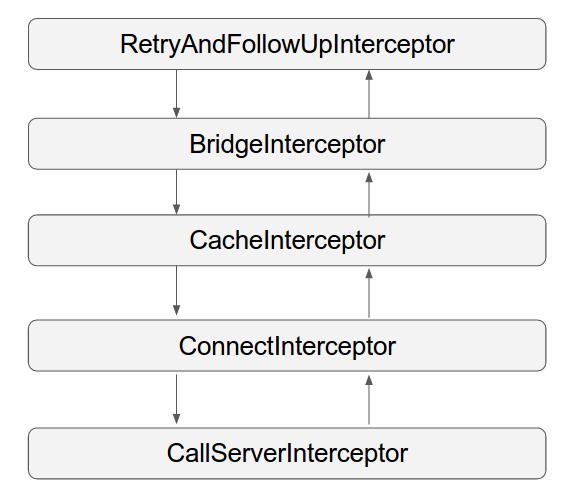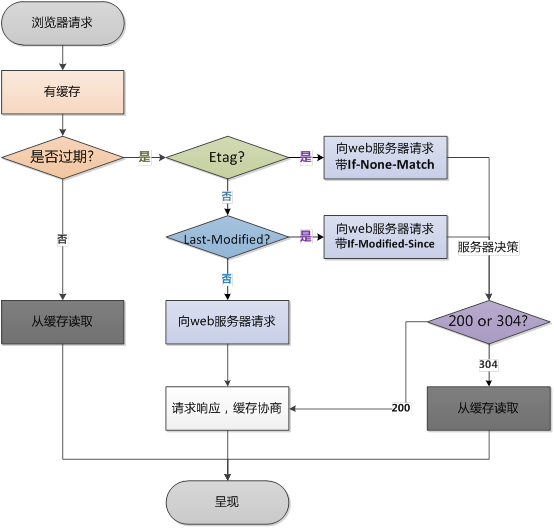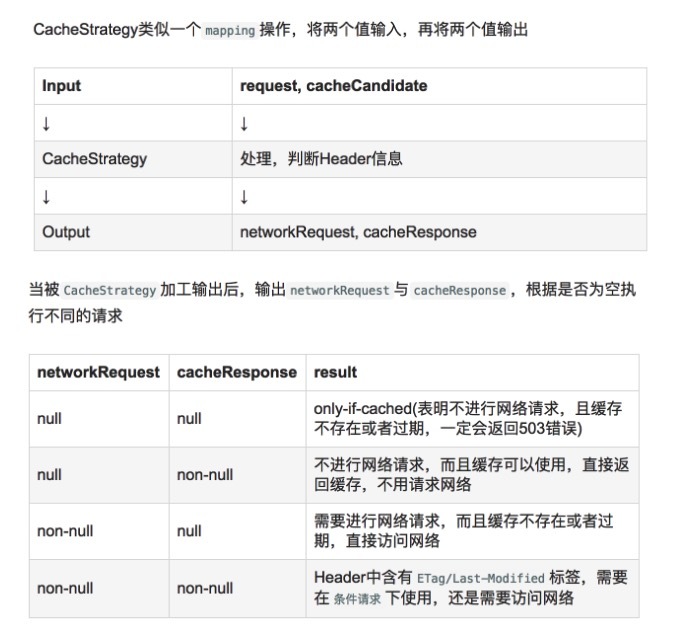揭秘网络框架第三篇: OkHttp 核心机制深入学习(彻底理解五个拦截器)
-
- OkHttp 核心机制深入学习
OkHttp 核心机制深入学习
第一节基础部分我们了解到,HTTP 请求信息、响应信息中有很多是重复的,通信过程中会很多种异常情况,根据响应码的不同,也需要做不同的处理。
那么多情况要处理,放到一两个类里想必会十分冗余,这个时候就是表演技术的时候了, OkHttp 采用了一种清晰、低耦合的分层责任链模式。
上一小节我们了解到, OkHttp 内置了 5 个拦截器,在每一个拦截器里,分别对请求信息和响应值做了处理,每一层只做当前相关的操作,这五个拦截器分别是:

他们的作用分别如下:
-
RetryAndFollowUpInterceptor:取消、失败重试、重定向 -
BridgeInterceptor:把用户请求转换为 HTTP 请求;把 HTTP 响应转换为用户友好的响应 -
CacheInterceptor:读写缓存、根据策略决定是否使用 -
ConnectInterceptor:实现和服务器建立连接 -
CallServerInterceptor:实现读写数据
掌握了这五个拦截器,我们就熟悉了 OkHttp 的核心,来挨个了解一下吧!
取消、失败重试、重定向
RetryAndFollowUpInterceptor 是内置拦截器中的第一个,也是我们接触最早的一个。在前面的 AsyncCall.execute() 方法中,通过拦截器链拿到响应值后,首先调用了 RetryAndFollowUpInterceptor.isCanceled() 方法判断当前请求是否取消:
//AsyncCall.execute()
@Override protected void execute() {
boolean signalledCallback = false;
try {
Response response = getResponseWithInterceptorChain();
if (retryAndFollowUpInterceptor.isCanceled()) { //判断是否取消请求
signalledCallback = true;
responseCallback.onFailure(RealCall.this, new IOException("Canceled"));
}
//...
}
拦截器最核心的就是拦截方法 intecept(Chain) ,我们直接看 RetryAndFollowUpInterceptor 的拦截方法吧:
//RetryAndFollowUpInterceptor.intercept()
@Override public Response intercept(Chain chain) throws IOException {
Request request = chain.request();
RealInterceptorChain realChain = (RealInterceptorChain) chain;
Call call = realChain.call();
EventListener eventListener = realChain.eventListener();
//首先创建了流引用管理的类 StreamAllocation
StreamAllocation streamAllocation = new StreamAllocation(client.connectionPool(),
createAddress(request.url()), call, eventListener, callStackTrace);
this.streamAllocation = streamAllocation;
int followUpCount = 0;
Response priorResponse = null;
while (true) { //有一个循环
if (canceled) { //检查当前请求是否被取消,如果这时请求被取消了,则会通过StreamAllocation释放连接
streamAllocation.release();
throw new IOException("Canceled");
}
Response response;
boolean releaseConnection = true;
try {
response = realChain.proceed(request, streamAllocation, null, null);
releaseConnection = false; //请求过程中,只要发生未处理的异常,releaseConnection 就会为true,一旦变为true,就会将StreamAllocation释放掉
} catch (RouteException e) {
// The attempt to connect via a route failed. The request will not have been sent.
if (!recover(e.getLastConnectException(), streamAllocation, false, request)) {
throw e.getLastConnectException();
}
releaseConnection = false;
continue;
} catch (IOException e) {
// An attempt to communicate with a server failed. The request may have been sent.
boolean requestSendStarted = !(e instanceof ConnectionShutdownException);
if (!recover(e, streamAllocation, requestSendStarted, request)) throw e;
releaseConnection = false;
continue;
} finally {
if (releaseConnection) {
streamAllocation.streamFailed(null);
streamAllocation.release();
}
}
//关联前一个响应
if (priorResponse != null) {
response = response.newBuilder()
.priorResponse(priorResponse.newBuilder()
.body(null)
.build())
.build();
}
//根据 code 和 method 判断是否需要重定向请求
Request followUp = followUpRequest(response, streamAllocation.route());
if (followUp == null) { //不需要重定向时直接返回结果
if (!forWebSocket) {
streamAllocation.release();
}
return response;
}
closeQuietly(response.body());
if (++followUpCount > MAX_FOLLOW_UPS) {
streamAllocation.release();
throw new ProtocolException("Too many follow-up requests: " + followUpCount);
}
if (followUp.body() instanceof UnrepeatableRequestBody) {
streamAllocation.release();
throw new HttpRetryException("Cannot retry streamed HTTP body", response.code());
}
//通常发生请求重定向时,url 地址将会有所不同
if (!sameConnection(response, followUp.url())) {
streamAllocation.release(); //释放原来的
streamAllocation = new StreamAllocation(client.connectionPool(),
createAddress(followUp.url()), call, eventListener, callStackTrace);
this.streamAllocation = streamAllocation;
} else if (streamAllocation.codec() != null) {
throw new IllegalStateException("Closing the body of " + response
+ " didn't close its backing stream. Bad interceptor?");
}
request = followUp;
priorResponse = response;
}
}
可以看到, RetryAndFollowUpInterceptor 的拦截操作中做了这么几件事:
- 首先创建了流引用管理的类 StreamAllocation,这个类非常重要,我们后面介绍
- 然后在一个 while 循环中调用拦截器链的
proceed()方法 - 拿到响应的过程中如果出现远端异常、IO 异常,就 continue 请求(即失败重试)
- 如果成功拿到响应,就释放当前连接
- 然后在
followUpRequest()方法中判断是否需要重定向,是的话就再请求
当不需要重定向时, followUpRequest() 会返回空 。我们来看下 followUpRequest() 方法如何决定是否需要重定向:
private Request followUpRequest(Response userResponse, Route route) throws IOException {
if (userResponse == null) throw new IllegalStateException();
int responseCode = userResponse.code();
final String method = userResponse.request().method();
switch (responseCode) { //根据响应码做相关操作
case HTTP_PROXY_AUTH: //407,代理服务器验证
Proxy selectedProxy = route != null
? route.proxy()
: client.proxy();
if (selectedProxy.type() != Proxy.Type.HTTP) {
throw new ProtocolException("Received HTTP_PROXY_AUTH (407) code while not using proxy");
}
return client.proxyAuthenticator().authenticate(route, userResponse);
case HTTP_UNAUTHORIZED: //401,未验证
return client.authenticator().authenticate(route, userResponse);
case HTTP_PERM_REDIRECT:
case HTTP_TEMP_REDIRECT:
// "If the 307 or 308 status code is received in response to a request other than GET
// or HEAD, the user agent MUST NOT automatically redirect the request"
if (!method.equals("GET") && !method.equals("HEAD")) {
return null;
}
// fall-through
case HTTP_MULT_CHOICE:
case HTTP_MOVED_PERM:
case HTTP_MOVED_TEMP:
case HTTP_SEE_OTHER:
// Does the client allow redirects?
if (!client.followRedirects()) return null;
String location = userResponse.header("Location");
if (location == null) return null;
HttpUrl url = userResponse.request().url().resolve(location);
// Don't follow redirects to unsupported protocols.
if (url == null) return null;
// If configured, don't follow redirects between SSL and non-SSL.
boolean sameScheme = url.scheme().equals(userResponse.request().url().scheme());
if (!sameScheme && !client.followSslRedirects()) return null;
// Most redirects don't include a request body.
Request.Builder requestBuilder = userResponse.request().newBuilder();
if (HttpMethod.permitsRequestBody(method)) {
final boolean maintainBody = HttpMethod.redirectsWithBody(method);
if (HttpMethod.redirectsToGet(method)) {
requestBuilder.method("GET", null);
} else {
RequestBody requestBody = maintainBody ? userResponse.request().body() : null;
requestBuilder.method(method, requestBody);
}
if (!maintainBody) {
requestBuilder.removeHeader("Transfer-Encoding");
requestBuilder.removeHeader("Content-Length");
requestBuilder.removeHeader("Content-Type");
}
}
//...
return requestBuilder.url(url).build();
case HTTP_CLIENT_TIMEOUT:
//...
if (userResponse.priorResponse() != null
&& userResponse.priorResponse().code() == HTTP_CLIENT_TIMEOUT) {
// We attempted to retry and got another timeout. Give up.
return null;
}
if (retryAfter(userResponse, 0) > 0) {
return null;
}
return userResponse.request();
case HTTP_UNAVAILABLE:
if (userResponse.priorResponse() != null
&& userResponse.priorResponse().code() == HTTP_UNAVAILABLE) {
// We attempted to retry and got another timeout. Give up.
return null;
}
if (retryAfter(userResponse, Integer.MAX_VALUE) == 0) {
// specifically received an instruction to retry without delay
return userResponse.request();
}
return null;
default:
return null;
}
}
在第一章我们介绍了一些比较冷门的响应码,这里就见到用处了。
followUpRequest() 根据响应码做了这些事:
- 如果 code 是 401 or 407 会调用我们构造
OkHttpClient时传入的Authenticator,做鉴权处理操作,返回处理后的结果 - 如果 code 是 307 or 308 重定向,且方法不是 GET 或 HEAD,就返回 null
- 如果 code 是 300、301、302、303,且构造
OkHttpClient时设置允许重定向,就从当前响应头中取出Location即新地址,然后构造一个新的 Request 再请求一次 - 如果 code 是 408 超时,且上一次没有超时,就再请求一次
- 如果 code 是 503 服务不可用,且上一次不是 503,就再请求一次
如果要处理 401 或者 407,我们就要在构造 OkHttpClient 时传入自定义的 Authenticator ,比如这样:
private OkHttpClient getOkHttpClient() {
return new OkHttpClient.Builder()
.authenticator(new Authenticator() {
@Nullable
@Override
public Request authenticate(final Route route, final Response response) throws IOException {
//这里根据响应做一些鉴权、新请求构造操作
return null;
}
})
.build();
}
在 followUpRequest() 方法结束之后,如果返回不为 null,说明要重新请求,就会把和这次请求地址不同的连接释放掉,创建新连接。
在这里我们频繁看到 StreamAllocation ,它主要用于管理客户端与服务器之间的连接,同时管理连接池,以及请求成功后的连接释放等操作,我们讲连接拦截器时介绍。
OK,至此我们了解了第一个拦截器 RetryAndFollowUpInterceptor ,小结一下它做的事:
- 创建一个
StreamAllocation - 发起请求
- 请求异常时会重试
- 根据响应码做鉴权、重定向和重试
- 重定向时如果地址不一致会释放连接
- 另外也保存是否取消的状态值,在重试、请求得到响应后都会判断是否取消
请求、响应转换
内置的拦截器中第二个是 BridgeInterceptor 。Bridge,桥,什么桥?连接用户请求信息和 HTTP 请求的桥梁。
BridgeInterceptor 负责把用户构造的请求转换为发送到服务器的请求、把服务器返回的响应转换为用户友好的响应。
来看下它的拦截方法:
// BridgeInterceptor.intercept()
@Override public Response intercept(Chain chain) throws IOException {
Request userRequest = chain.request();
Request.Builder requestBuilder = userRequest.newBuilder();
RequestBody body = userRequest.body();
if (body != null) { //根据请求体添加 header
MediaType contentType = body.contentType();
if (contentType != null) {
requestBuilder.header("Content-Type", contentType.toString());
}
long contentLength = body.contentLength();
if (contentLength != -1) {
requestBuilder.header("Content-Length", Long.toString(contentLength));
requestBuilder.removeHeader("Transfer-Encoding");
} else {
requestBuilder.header("Transfer-Encoding", "chunked");
requestBuilder.removeHeader("Content-Length");
}
}
if (userRequest.header("Host") == null) { //添加 Host header
requestBuilder.header("Host", hostHeader(userRequest.url(), false));
}
if (userRequest.header("Connection") == null) { //添加连接信息 header
requestBuilder.header("Connection", "Keep-Alive");
}
boolean transparentGzip = false;
if (userRequest.header("Accept-Encoding") == null && userRequest.header("Range") == null) {
transparentGzip = true;
requestBuilder.header("Accept-Encoding", "gzip");
}
List<Cookie> cookies = cookieJar.loadForRequest(userRequest.url());
if (!cookies.isEmpty()) { //从本地加载 cookie 信息
requestBuilder.header("Cookie", cookieHeader(cookies));
}
if (userRequest.header("User-Agent") == null) {
requestBuilder.header("User-Agent", Version.userAgent());
}
Response networkResponse = chain.proceed(requestBuilder.build());
HttpHeaders.receiveHeaders(cookieJar, userRequest.url(), networkResponse.headers());
Response.Builder responseBuilder = networkResponse.newBuilder()
.request(userRequest);
if (transparentGzip
&& "gzip".equalsIgnoreCase(networkResponse.header("Content-Encoding"))
&& HttpHeaders.hasBody(networkResponse)) {
GzipSource responseBody = new GzipSource(networkResponse.body().source());
Headers strippedHeaders = networkResponse.headers().newBuilder()
.removeAll("Content-Encoding")
.removeAll("Content-Length")
.build();
responseBuilder.headers(strippedHeaders);
String contentType = networkResponse.header("Content-Type");
responseBuilder.body(new RealResponseBody(contentType, -1L, Okio.buffer(responseBody)));
}
return responseBuilder.build();
}
可以看到就是在请求前添加一下 header,请求后做完解压缩处理等,然后移除一些 header。
我们记录一下都具体添加了哪些信息吧,请求前:
- 如果这个请求有请求体,就添加
Content-Type,Content-Length等 - 如果这个请求没有
Host,就通过 url 来获取 Host 值添加到 Header 中 - 如果这个请求没有接收的数据类型
Accept-Encoding,且没指定接收的数据范围,就添加默认接受格式为 gzip - 去
CookieJar中根据 url 查询 Cookie 添加到 Header - 如果当前没有,就添加
User-Agent信息
发起请求后:
- 解析响应 Header 中的 Cookie
- 如果想要数据的格式是 gzip,就创建
GzipSource进行解压,同时移除Content-Encoding和Content-Length
这个拦截器做的很简单,用一个图就可以描述它的功能:

缓存处理

第三个拦截器是缓存处理拦截器 CacheInterceptor ,它的重要性用一句话来描述: 最快的请求就是不请求,直接用缓存。
缓存用得好,响应快的不得了,但是如果一不小心用错了缓存,会导致在对的时间遇到错的数据,遗憾终生。
这一节我们来看看 OkHttp 的缓存处理是如何做的,不过在这之前先再补补一些基础知识。
HTTP 缓存策略
在 HTTP 协议中,定义了一些缓存相关的 Header:
-
Cache-Control -
Etag,If-None_match -
LastModified,If-Modified-Since -
Expired
首先看下 Cache-Control ,即缓存策略,它的值关系到客户端是否使用缓存,请求和响应分别有这些值:
- 请求:
- no-cache:不使用缓存的实体,直接从服务器去取
- only-if-cached:表示不进行与网络相关的交互,只返回已经缓存且 满足要求 的数据,否则的话返回 504 错误。
- max-age:缓存可以使用的最大时间
- max-stale:已过期的缓存在多少时间内仍可以继续使用(类似保质期),可以接受过去的对象,但是过期时间必须小于 max-stale 值
- min-fresh:最小新鲜度,只接受其新鲜生命期大于当前 Age 跟 min-fresh 值之和的缓存对象
- 响应:
- public:可以用 Cached 内容回应任何用户
- private:只能用缓存内容回应先前请求该内容的那个用户
- no-cache:缓存服务器不能对资源进行缓存
- no-store:不缓存
- max-age:本响应包含的对象的过期时间
不同于拦截器设置缓存,CacheControl 是针对 Request 的,所以它可以针对每个请求设置不同的缓存策略。
剩下的那些缓存相关 Header 使用规则如下图所示:

HTTP 定义的规范,首先会根据 CacheControl 来判断是否使用缓存,如果使用缓存,就去判断当前缓存是否新鲜,是否新鲜这样判断:
- 如果缓存信息里有
Etag,就向服务器发送带If-None-Match的请求,服务器进行决策 - 如果没有
Etag就看有没有Last-Modified,有的话向服务器发送带If-Modified-Since的请求,由服务器进行决策
服务器验证缓存有效性后,如果缓存仍可以使用,就返回 304;如果 code 不是 304,客户端就需要从响应里拿数据,同时更新缓存。
服务器返回的响应头里可能有 Expired ,这个值表示当前响应将在什么时候过期,对于过期了的对象,只有在跟服务器验证了其有效性后,才能用来响应客户请求。例如: Expires:Sat, 23 May 2009 10:02:12 GMT 。
OkHttp 的缓存策略
在基本了解 HTTP 协议中定义的缓存策略后,我们来看看 OkHttp 的缓存拦截器是如何实现的:
public final class CacheInterceptor implements Interceptor {
final InternalCache cache;
public CacheInterceptor(InternalCache cache) {
this.cache = cache;
}
@Override public Response intercept(Chain chain) throws IOException {
Response cacheCandidate = cache != null
? cache.get(chain.request())
: null; //先去缓存拿,拿到了用不用得看情况
//...
return response;
}
首先可以看到的是,缓存拦截器会先去 InternalCache 里找有没有缓存。
这个 InternalCache 唯一的实现是在 OkHttp.Cache 中,它就是一个包装类,还是调用的 OkHttp.Cache 的方法,我们直接看 Cache.get() 方法:
public final class Cache implements Closeable, Flushable {
private static final int VERSION = 201105;
private static final int ENTRY_METADATA = 0;
private static final int ENTRY_BODY = 1;
private static final int ENTRY_COUNT = 2;
final InternalCache internalCache = new InternalCache() {
@Override public Response get(Request request) throws IOException {
return Cache.this.get(request);
}
//...
};
final DiskLruCache cache;
public Cache(File directory, long maxSize) {
this(directory, maxSize, FileSystem.SYSTEM);
}
Cache(File directory, long maxSize, FileSystem fileSystem) {
this.cache = DiskLruCache.create(fileSystem, directory, VERSION, ENTRY_COUNT, maxSize);
}
public static String key(HttpUrl url) {
return ByteString.encodeUtf8(url.toString()).md5().hex();
}
@Nullable Response get(Request request) {
String key = key(request.url());
DiskLruCache.Snapshot snapshot;
Entry entry;
snapshot = cache.get(key);
if (snapshot == null) {
return null;
}
//...
entry = new Entry(snapshot.getSource(ENTRY_METADATA));
Response response = entry.response(snapshot);
//...
return response;
}
从上面的代码可以看到的是,OkHttp 中的缓存使用的是基于文件系统的磁盘缓存,缓存的 key 是 url 的 md 值。
由于调用方可以 针对某个请求是否要使用缓存进行配置 (通过给 Request 配置 CacheControl 属性),比如这样:
Request request = new Request.Builder()
.cacheControl(new CacheControl.Builder().noCache().build())
.url("http://publicobject.com/helloworld.txt")
.build();
因此我们从 cache 拿到缓存响应后,还需要做这几件事:
- 看当前调用方允不允许使用缓存(判断
request.cacheControl()的值) - 允许使用缓存的话,验证这个缓存还有没有效
在 CacheInterceptor 中,是通过 CacheStrategy 来判断缓存能否使用的。
在 CacheInterceptor.intercept() 中我们可以看到,去 cache 里拿到缓存响应后,接着又调用了 CacheStrategy :
//CacheInterceptor.intercept()
@Override public Response intercept(Chain chain) throws IOException {
Response cacheCandidate = cache != null
? cache.get(chain.request())
: null; //去缓存拿缓存响应
//判断缓存能否使用
CacheStrategy strategy = new CacheStrategy.Factory(now, chain.request(), cacheCandidate).get(); /
Request networkRequest = strategy.networkRequest;
Response cacheResponse = strategy.cacheResponse;
//...
}
这个 CacheStrategy 如何判断缓存能否使用的呢?我们通过一张图来解释:

如图所示, CacheStrategy 的工厂方法构造需要两个参数:请求信息和拿到的缓存响应。
//两个参数:请求信息和拿到的缓存响应 CacheStrategy strategy = new CacheStrategy.Factory(now, chain.request(), cacheCandidate).get();
在其内部,它会根据用户对当前请求设置的 CacheControl 和缓存响应的时间、ETag 、 LastModified 或者 ServedDate 等 Header 进行判断,最后输出两个值 :
//加工后拿到两个值,根据这两个值得情况决定是请求网络还是直接返回缓存 Request networkRequest = strategy.networkRequest; Response cacheResponse = strategy.cacheResponse;
根据这两个值是否为空的四种情况,有不同的处理,分别如下:
1. networkRequest 和 cacheResponse 都是空,表示调用端要求只用缓存,但缓存不可用了,只好返回 504 响应
// If we're forbidden from using the network and the cache is insufficient, fail.
if (networkRequest == null && cacheResponse == null) {
return new Response.Builder()
.request(chain.request())
.protocol(Protocol.HTTP_1_1)
.code(504)
.message("Unsatisfiable Request (only-if-cached)")
.body(Util.EMPTY_RESPONSE)
.sentRequestAtMillis(-1L)
.receivedResponseAtMillis(System.currentTimeMillis())
.build();
}
504 Gateway Timeout
作为网关或者代理工作的服务器尝试执行请求时,未能及时从上游服务器(URI标识出的服务器,例如HTTP、FTP、LDAP)或者辅助服务器(例如DNS)收到响应。
2. networkRequest 为空,但 cacheResponse 不为空,就直接返回缓存响应
// If we don't need the network, we're done.
if (networkRequest == null) {
return cacheResponse.newBuilder()
.cacheResponse(stripBody(cacheResponse))
.build();
}
3. networkRequest 不为空,表示不用缓存或者缓存有效性需要验证,这时就需要请求网络了
- 如果
cacheResponse不为空,且请求的响应码是 304,表示缓存还可以用,就直接返回cacheResponse** - 否则就返回网络请求的响应
下面的代码就是这种情况的逻辑:
```
Response networkResponse = null;
try {
networkResponse = chain.proceed(networkRequest);
} finally {
// If we're crashing on I/O or otherwise, don't leak the cache body.
if (networkResponse == null && cacheCandidate != null) {
closeQuietly(cacheCandidate.body());
}
}
- 本文标签: authenticate http 配置 cookies CTO web Connection https cache NSA value 协议 src cat Keep-Alive CEO zip final struct message IDE key ldap client tar id 时间 rmi 参数 ip ACE 数据 连接池 Select ssl build 文件系统 代码 快的 tab 生命 UI equals 解析 服务器 ftp DNS IO 管理 list
- 版权声明: 本文为互联网转载文章,出处已在文章中说明(部分除外)。如果侵权,请联系本站长删除,谢谢。
- 本文海报: 生成海报一 生成海报二











![[HBLOG]公众号](https://www.liuhaihua.cn/img/qrcode_gzh.jpg)

